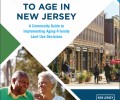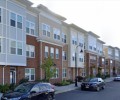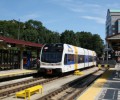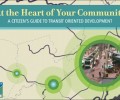Research Reports
New Jersey Future produces data-driven, fact-based research reports on issues of land use and development, transportation, housing, and demographics in the Garden State.
In addition, New Jersey Future interns have the opportunity to focus on specific policy, research or communications projects, many of which culminate in special intern reports.
- Weathering the Storms: Creating Aging-Friendly Communities Amid Climate Change

Climate change is already disrupting where people can live, including in New Jersey. As a coastal state, New Jersey faces rising sea levels, stronger storms, and increased inland flooding, as seen with Superstorm Sandy (2012) and storms Isaias (2020) and Ida (2021).
- The Case for a Successful Vehicle Miles Traveled Reduction Effort in New Jersey

New Jersey has set ambitious greenhouse gas reduction goals: 50% by 2030 and 80% by 2050. While the state's 2019 Energy Master Plan primarily focuses on electric vehicle adoption to reduce transportation emissions, the US Department of Transportation1 and many other states advocate for a dual approach that combines fleet electrification with reducing Vehicle Miles Traveled (VMT).
- Funding Opportunities and Programmatic Insights for Advancing Shared Use Paths, Trails, and Greenways in New Jersey

Trail networks are valuable assets that strengthen communities and support regional vitality. They provide options for walking, biking, and rolling, connecting people to key destinations and fostering a sense of place.
- Sustainability and Climate Adaptation Planning: an Integrated Guide for Highlands Region Municipalities

This resource was developed through the vision and direction of the New Jersey Highlands Water Protection and Planning Council (Highlands Council).
- A Snapshot of Housing Supply, Affordability, and Land Use in New Jersey

New Jersey—along with many other parts of the country—is experiencing a housing shortage, driving up rents and home prices and prompting many households to leave the state in search of cheaper housing elsewhere.
- Breaking Barriers: A Comparative Analysis of Affordable Housing Compliance and Diversity in Morris and Monmouth Counties, New Jersey

New Jersey is an expensive state, with among the highest housing costs in the country. It is also one of the most segregated states in the nation by both income and race, despite being one of the most racially diverse states overall.
- Improving a Program That Works: Prioritizing New Jersey Water Bank Projects in Disadvantaged Communities

By almost any measure, New Jersey’s water infrastructure financing program is a success, having provided over $9 billion in low-cost financing for water and wastewater projects since its inception in 1987.
- Guide to Local Climate Change Adaptation Planning

Working with the NJ Department of Environmental Protection, Sustainable Jersey, and statewide partners, New Jersey Future led development of the Guide to Local Climate Change Adaptation Planning, providing a model Climate Change-Related Hazard Vulnerability Assessment (CCRHVA) and planning process for New Jersey Municipalities that satisfies the requirements of the 2021 MLUL amendment.
- Rolling Along: Why New Jersey Should Join Other States and Offer an E-Bike Incentive Program

Electric bicycles, along with programs intended to incentivize their adoption, are rolling out across the country and New Jersey can’t afford to be left behind in this transportation revolution.
- Reducing the Need to Drive Is a Win for Both Climate Change and Quality of Life

The cleanest car trips are the ones that are never taken. Governments at all levels should keep this in mind when formulating strategies for reducing carbon emissions from their transportation sectors. So far, such strategies have focused primarily on electrifying the vehicle fleet. But we can cut total transportation emissions not only by converting to vehicles that do not burn fossil fuels but also by reducing the need to drive so much in the first place.
- Promoting and Maintaining Racial Integration: Lessons from Selected New Jersey Towns

New Jersey Future’s new report, “Promoting and Maintaining Racial Integration: Lessons from Selected New Jersey Towns,” examines what towns can do and have done to foster stable racial integration since 2000. To explore possible answers, New Jersey Future summer intern Isabel Yip researched examples of New Jersey towns that have achieved and maintained an above-average level of diversity over two decades, to see what state and local leaders and policy makers might be able to learn from them.
- Young People are Leaving New Jersey: Exploring Potential Explanatory Variables

This report, prepared by students in a Princeton University class, looks at housing supply numbers, types of housing supply, median home value, and median rent prices relative to the 25-44 year old population from 2015 to 2019 to determine key trends that potentially affect this population’s migration tendencies.
- Lead in Drinking Water in Child Care Facilities: Ensuring the Future for New Jersey’s Children

This Jersey Water Works report identifies 10 priority recommendations to protect young children from lead in drinking water in the state’s regulated child care facilities.
- Local Options/Local Actions Resilience Strategies Case Studies

New Jersey Future analyzed 350 innovative strategies applied in 76 cities or regions that could serve as model initiatives to develop the 15 strategies detailed in the Local Options/Local Actions: Resilience Strategies Case Studies report for the New Jersey Department of Environmental Protection (NJDEP).
- Creating Great Places to Age for Every Person in Every Neighborhood

America’s population is aging, and although most older Americans express a desire to “age in place,” some communities were not necessarily built with the unique needs of older people in mind.
- Warehouse Sprawl: Plan Now or Suffer the Consequences

The warehouse development that has been steadily spreading south into farm fields along the New Jersey Turnpike might be a preview of things to come if we fail to plan for the growth in the movement and storage of stuff.
- Older Homeowners in Car-Dependent Suburbs Face a Reckoning

Older adults in New Jersey looking to sell their homes—most of which are single-family detached houses—as younger generations continue to prefer smaller homes in walkable communities.
- Creating Places To Age: A Community Guide to Implementing Aging-Friendly Land Use Decisions

New Jersey Future has created the Creating Places To Age: A Community Guide to Implementing Aging-Friendly Land Use Decisions to provide communities with a step-by-step process to make it easier to design for the needs of older residents.
- School District Fragmentation and Residential Segregation

If New Jersey wants to address its status as one of the most segregated states in the country, mitigating its exclusionary land-use incentives by organizing and funding public education at a higher level of government might be a good place to start. Read the latest installment in our Geography of Equity and Inclusion series.
- The Geography of Poverty and Race in New Jersey

Inspired by a study earlier this year by the Economic Innovation Group (EIG), New Jersey Future performed an analysis of poverty in New Jersey over the last two decades, including an analysis of how the demographics of high-poverty neighborhoods have changed.
- Broadband for All: The Geography of Digital Equity in New Jersey

For New Jersey’s recovery from the pandemic to be successful, everyone should have the ability to access the internet at reasonable speeds with affordable prices regardless of their geography or income.
- The Black-White Homeownership Gap in New Jersey

Where we build our housing, the type of housing we build, and for whom we build it affects our environment, our quality of life, and how segregated a state we will live in.
- Municipal Strategies to Diversify Housing Stock For An Aging Population: A Case Study Report

A new report by New Jersey Future, Municipal Strategies to Diversify Housing Stock for an Aging Population: A Case Study Report, is part of New Jersey Future’s Creating Great Places to Age program. August 2020.
- A Shift to Working From Home Raises Many Questions About Potential Effects on Other Aspects of Daily Life

With the necessity of a daily commute to the office now being questioned, it is worth considering what might emerge as some of the longer-term effects if a significant portion of New Jersey's employed population ends up working from home permanently, or multiple days a week. August 2020.
- Lead in Drinking Water: A Permanent Solution for New Jersey

Lead in Drinking Water: A Permanent Solution for New Jersey outlines actions New Jersey can take to virtually eliminate lead in drinking water in 10 years. October 2019.
- Trenton Transit Center Strategic Action Plan

The Trenton Transit Center Strategic Action Plan, prepared by New Jersey Future for the economic-development organization Greater Trenton in partnership with architecture and planning firm Clarke Caton Hintz, lays out strategies and implementation tactics for transforming the station area into a vibrant and dynamic district. October 2018.
- Unlocking Green Infrastructure Financing Opportunities

This report examines recent New Jersey Water Bank successes in funding green infrastructure projects, and looks at steps both applicants and the bank itself can take to make accessing green infrastructure funding even easier. July 2018.
- Sustainable and Resilient Coastal Communities: A Comprehensive Coastal Hazard Mitigation Strategy

This report outlines a comprehensive set of strategies coastal communities can use to make themselves more resilient to severe weather and sea-level rise, and ways the state can help communities implement these strategies. December 2017.
- Where Are We Going: Implications of Recent Demographic Trends in New Jersey

This report finds that the younger generation flocks to neighborhoods in New Jersey where they can live, work, and play, but there might not be enough of those places in our state to keep them here. September 2017.
- Lead in School Drinking Water: Preliminary Analysis of Reported Testing Results

An analysis of data reported to the Department of Education shows positive test results for lead in drinking water from more than 300 schools in districts in all areas of the state, but the data are incomplete. August 2017.
- Assessment of the New Jersey Low Income Housing Tax Credit Program

This report shows that results from New Jersey's low income housing tax credit program contrast with national numbers. May 2017.
- Redeveloping the Norm: Identifying and Overcoming Developer Obstacles to Redevelopment in New Jersey

This report identifies strategies to lower both cost and risk in redevelopment projects, as redevelopment increasingly becomes the norm for accommodating growth in New Jersey. January 2016.
- Creating Places To Age: Housing Affordability and Aging-Friendly Communities

In this report, New Jersey Future analyzed housing affordability in each New Jersey municipality, to see where households headed by someone 65 or older have high housing costs. The places where housing cost burden is greatest fall into two groups: towns that are expensive for everyone, and towns that are dominated by larger, single-family housing stock. December 2015.
- Fiscal Implications of Development Patterns: Roads in New Jersey

In this report, New Jersey Future and Smart Growth America analyzed per-capita road usage. The results show that places with the highest activity density have the lowest per-capita usage, suggesting per-capita road-maintenance costs can be reduced by even marginal increases in density. November 2015.
- In Deep: Helping Sandy-Affected Communities Address Vulnerability and Confront Risk

An interim report, three years after Hurricane Sandy, on New Jersey Future's groundbreaking local recovery planning manager program, including lessons learned and recommendations. October 2015.
- OFF TRACK? An Assessment of Mixed-Income Housing around New Jersey’s Transit Stations

An analysis of household income distributions in the neighborhoods around New Jersey's transit stations shows that not all station areas offer the benefits of transit access across all income levels. June 2015.
- New Jersey’s Economic Opportunity Act and Smart Growth: A Progress Report

The Economic Opportunity Act of 2013 included additional incentives for projects destined for "smart-growth" areas. This report analyzes how effective the updated incentives have been at directing growth to those areas. December 2014.
- Growing Smart and Water Wise

Development in the Pinelands growth areas has affected water resources and will continue to exert pressures going forward. This report highlights what can be done by municipal, regional and state agencies to minimize their negative impacts. July 2014.
- Ripple Effects

This report and related case studies summarize the state of urban water infrastructure in New Jersey and how it affects residents and businesses. May 2014.
- Creating Places To Age in New Jersey

There is a significant mismatch in New Jersey between where large numbers of older residents live and which municipalities are most prepared to accommodate them. This report matches every municipality against four age-friendliness indicators, and analyzes the degree to which New Jersey's older residents are living in places that, from a land-use perspective, are not prepared to accommodate their changing needs. January 2014.
- Targeting Transit: Assessing Development Opportunities Around New Jersey's Transit Stations

New Jersey has 243 transit facilities, ranging from small single-track stations to major multi-line hubs. The unique characteristics of each station, of its immediate neighborhood, and of its surrounding municipality mean that a wide variety of development strategies should be brought to bear in order to maximize each location's potential. This report shows how data assembled by New Jersey Future can be used to make decisions on how to target various kinds of transit-oriented development efforts. September 2012.
- A Review of the Legal Framework for County Planning in New Jersey

A new report, the first of two, outlines the legal framework for county planning in New Jersey, and highlights where that framework is either unclear or inconsistent with current planning practices. May 2012.
- Preserving Land through Market Real Estate Transactions

This report from New Jersey Future examines the use of non-contiguous clustering as a land-preservation tool in nine New Jersey municipalities. May 2012.
- Filling in the Gaps

An assessment of how comprehensively New Jersey's Department of Transportation has implemented its Complete Streets Policy. September 2011.
- A Citizen's Guide to Transit-Oriented Development

A train station can provide increased mobility and increase the number of people who have access to goods, services and employment opportunities. It can be the core of a vibrant, walkable downtown. New Jersey Future's easy-to-understand guide provides answers to the most-asked questions about this kind of development. March 2011.
- Built Out but Still Growing

Geographic patterns in building permit activity offer insights into macroeconomic forces that influence people’s residential location decisions. They provide a preview into what types of places will be gaining population in the future. This report compares the 10 years’ worth of building permit data through 2009 with that of the previous decade. December 2010.
- Chasing Their Tails: Municipal Ratables Chase Doesn't Necessarily Pay

Research that examines whether the popular belief is true that municipalities with the highest concentrations of commercial properties also tend to have the lowest residential property tax rates. July 2010.
- Getting to Work: Reconnecting Jobs With Transit

How New Jersey's employment patterns have dispersed away from urban centers in the last 25 years, and why it's important to the future of the state to bring jobs back to transit-accessible areas. November 2008.
- Route 1 Planning Through Partnerships

Residential growth is happening further and further away from Route 1's employment centers, making it harder for employers to recruit talent and leading them to contemplate locating elsewhere. Interviews with local, regional and county officials from the jurisdictions along Route 1 identified barriers to center-based growth and steps that can be taken to encourage it. July 2007.
- Moving Out: New Jersey's Population Growth and Migration Patterns

New Jersey's natural population growth has begun to slow, but its land development has not: Its existing population is continuing its outward spread from urban areas and inner-ring suburbs to more exurban areas. June 2006.
- Race to the Middle: What the Homogenization of Population Density is Costing New Jersey

New Jersey is engaged in a “race for the middle” of the density scale. The spread-out developments proliferating across the state’s midsection are wasteful of land, money, and time, and are generating costs that will burden New Jersey’s taxpayers for decades to come. August 2004.
- Smart Conservation: The “Green” Side of Smart Growth

In New Jersey the elements of Smart Conservation are at odds with natural resource and farmland preservation. This report reviews the state's land conservation programs, compares them with land-conservation best practices from other jurisdictions, and issues a set of recommendations for improving the state's land conservation efforts. August 2003.
- “Realistic Opportunity?” The Distribution of Affordable Housing and Jobs in New Jersey

New Jersey needs to overhaul its housing policy if it's going to achieve its goal of distributing affordable housing equitably while ensuring that places with large or growing numbers of jobs also offer affordable housing to workers. July 2003.
- Assessment of Municipal Resource Conservation Performance

This project reviews local government policy regarding natural resource conservation in a sampling of 44 New Jersey towns, and finds that a combination of policies are increasingly putting our natural resources at risk for development, often far beyond the land's carrying capacity. June 2001.
- Rethinking Farmland Preservation in New Jersey

An examination of the state of farmland preservation in New Jersey, including its challenges, coming trends and recommendations for the future. May 2001.
- Achieving Genuine Prosperity

An examination of the problems caused by recent development patterns in New Jersey, and recommended steps to address them through smart-growth principles. April 2001.
- Case Study: Hopewell Township

The Merrill Lynch project in Hopewell Township is the result of 25 years of zoning and planning involving a patchwork of state, county, corporate and local agencies, each focused on its own expertise and needs. It offers a textbook case study of the flaws in New Jersey‘s unruly system of land-use governance. August 2000.
Intern Reports
- The Hidden Impact of the Built Environment: Designing Pedestrian-Friendly Spaces for Enhanced Health and Accessibility for Elderly & Aging Populations in New Jersey 01-2025 (Intern Report)
- Jersey Water Works Water Infrastructre Funding Report 06-2017 (Intern Report)
- New Jersey Future Assessing the Federal Approach to Identifying Gentrification 08-16 (Intern Report)
- New Jersey Future Redeveloping the Norm 01-16 (Intern Report)
- New Jersey Future Stormwater Utilities Report 9-14 (Intern Report)
- Social Innovation and Smart Growth 9-13 (Intern Report)
- Statutory and Regulatory Barriers to Green Infrastructure in New Jersey 1-13 (Intern Report)
- Somerset County Investment Framework 1-13 (Intern Report)
- Innovation Districts as Economic Growth Strategy 9-12 (Intern Report)
- Case Studies of Non-Contiguous Clustering in New Jersey 04-12
- County Planning in New Jersey 4-12 (Intern report)
- Financial Benefits of Density in Two New Jersey Downtowns 7-11 (Intern report)
- Assessment of Solar Siting in New Jersey 5-11 (Intern report)
- Case Studies in Transfer of Development Rights 8-10 (Intern report)
- Best Practices in State and Regional Planning 5-11 (Intern report)











